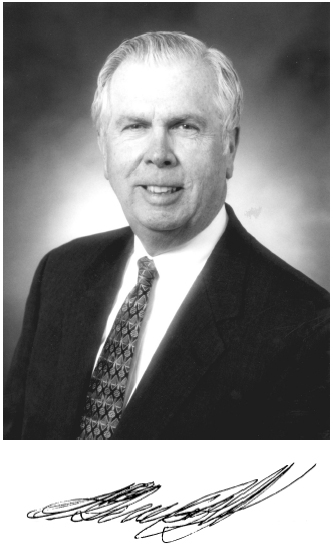
1935–2013
Elected in 2000
“For leadership in raising the standards of the engineering profession for construction of buildings and bridges.”
BY METE SOZEN
On March 1, 2013, one of the most brilliant minds in structural engineering, that had delivered its promise over and over again through a long and successful career, was lost. That was the day WILLIAM GENE CORLEY closed his eyes for the last time.
Gene was born in Shelbyville, Illinois, a small town south of Decatur, to Clarence W. and Mary Douthit Corley in 1935. Upon finishing high school in 1954, he attended the University of Illinois, Urbana, where he obtained his BS in civil engineering in 1958. While there he was a member of the ROTC and served as president of the Varsity Men’s Glee Club. His sustained success as a student earned him a place on the Bronze Tablet of 1958, limited to the top 3 percent of the graduating class. Encouraged by the civil engineering faculty to continue his education at the university, he earned his MS in 1960—the year after he married Lynd Wertheim—and his PhD in 1961. During that time he also produced two works that have stood the test of time: a simple and effective solution for time-dependent deflections of reinforced concrete beams, and a new perspective that expanded the application domain of the equivalent-frame analysis for reinforced concrete slabs.
In 1961 Gene joined the US Army Corps of Engineers at Fort Belvoir, Virginia, where he earned the rank of captain. In 1964 he took the position of research engineer with the Portland
Cement Association (PCA) in Skokie, Illinois. When PCA incorporated Construction Technology Laboratories (CTL Group) as a separate entity in 1987, he became CTL’s vice president.
At CTL Gene became one of the outstanding forensic engineers of his time. His interests and talents were multidimensional. He sang with his wife in the Chicago Symphony Orchestra Chorus, and served as president of the board of directors of Association House, chairman of the District School Board Caucus, and a member of the board of directors for the mid-America chapter of the American Red Cross. He was also a member of the Columbian Society and the Chicago Museum of Science and Industry. Always loyal to his alma mater, he was a member of the University of Illinois President’s Council and Civil Engineering Alumni Association (1988–1994), serving as the association’s president in 1993–1994.
He was eminently successful in his professional work. In 1995 he cochaired the team of select engineers that produced the investigation report of the Murrah Federal Building in Oklahoma City after it was damaged by a bomb. He was an advisor on the investigation of the fatal fire (2001) at the Branch Davidian complex in Waco, Texas. He led the investigative team for the two World Trade Center Buildings that collapsed in 2001 as a result of aircraft impact.
He also served selflessly and effectively on committees of the American Society of Civil Engineers (ASCE), American Concrete Institute (ACI), Building Seismic Safety Council, Chicago Committee on High-Rise Buildings, Earthquake Engineering Research Institute, Illinois Building Commission, Illinois Seismic Safety Task Force, Institute for Business and Home Safety, International Standards Organization, Mid-America Earthquake Center, National Association for Railroad Safety, National Council of Examiners for Engineering and Surveying, RILEM, Post-Tensioning Institute, Structural Engineers World Congress, and Illinois Governor’s Earthquake Preparedness Task Force.
He was elected to the National Academy of Engineering in 2000, and became an honorary member of ASCE in 2001 and of ACI in 2003. Professional associations recognized his contributions through dozens of awards, including the ASCE’s Opal and T.Y. Lin awards; the ACI’s Alfred E. Lindau Award, Delmar L. Bloem Distinguished Service Award, Arthur J. Boase Award, Henry C. Turner Medal, and Wason Medal for Materials Research; the John F. Parmer Award of the Structural Engineers Association of Illinois; and the Martin P. Korn Award of the Precast/Prestressed Concrete Institute. The University of Illinois recognized him as Civil Engineering Distinguished Alumnus (1995), College of Engineering Distinguished Alumnus (2001), and Chicago Illini of the Year (2004).
Looking back it appears phenomenal that among his myriad professional activities he found time to develop deep and warm relationships with a large circle of friends. Gene was a loving husband to Lynd, a doting father to their children Anne, Bob, and Scott, and remained close to their nine grandchildren.
He was so good in so many things that it is difficult to choose one of his accomplishments as the best. But his chairmanship of the ACI Building Code Committee is a good example. The committee is a tough debating society that is often the scene of the clash of corporate, academic, and personal goals. Many who assumed the chairmanship with good intentions found themselves taking sides and alienating believers in one cause or the other. During his six-year stint as chair, Gene led the committee to notable achievements and managed to arrive at satisfactory compromises while creating lasting friendships among those with differing views. He was a born leader as well as a wonderful and charming person.
In closing, the writer cannot help but paraphrase the Bard, “Here was William Gene Corley! When comes such another?”




